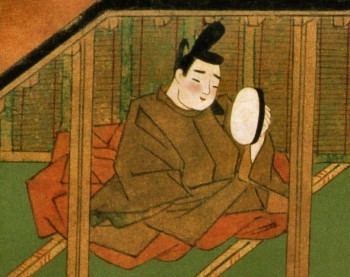Reign 585–587 Name Emperor Yomei | Died 587 (aged 69) | |
 | ||
Burial Kawachi no Shinaga no hara no misasagi (Osaka) | ||
Emperor Yōmei (用明天皇, Yōmei-tennō, 3 October 585 – 21 May 587) was the 31st Emperor of Japan, according to the traditional order of succession.
Contents

Yōmei's reign spanned the years from 585 until his death in 587.
Traditional narrative
He was called Tachibana no Toyohi no Mikoto (橘豊日尊) in the Nihon Shoki. He was also referred to as Prince Ōe (大兄皇子, Ōe no Miko, literally crown prince) and Prince Ikebe (池辺皇子, Ikebe no Miko) after the palace in which he lived. He acceded to the throne after the death of his half brother, Emperor Bidatsu.
The influential courtiers from Emperor Bidatsu's reign, Mononobe no Moriya, also known as Mononobe Yuge no Moriya no Muraji or as Ō-muraji Yuge no Moriya, and Soga no Umako no Sukune, both remained in their positions during the reign of Emperor Yōmei. Umako was the son of Soga Iname no Sukune, and therefore, he would have been one of Emperor Yōmei's cousins.
Yōmei's contemporary title would not have been tennō, as most historians believe this title was not introduced until the reigns of Emperor Tenmu and Empress Jitō. Rather, it was presumably Sumeramikoto or Amenoshita Shiroshimesu Ōkimi (治天下大王), meaning "the great king who rules all under heaven." Alternatively, Yōmei might have been referred to as (ヤマト大王/大君) or the "Great King of Yamato."
Emperor Yōmei's reign lasted only two years; and he died at the age of 69.
Because of the brevity of his reign, Emperor Yōmei was not responsible for any radical changes in policy, but his support of Buddhism created tension with supporters of Shintoism who opposed its introduction. According to Nihon Shoki, Emperor Yomei believed both in Buddhism and Shintoism. Moriya, the most influential supporter of Shintoism, conspired with Emperor Yōmei's brother, Prince Anahobe, and after Emperor Yomei's death they made an abortive attempt to seize the throne. Although Emperor Yōmei is reported to have died from illness, this incident and the brevity of his reign have led some to speculate that he was actually assassinated by Moriya and Prince Anahobe.
The actual site of Yōmei's grave is known. This emperor is traditionally venerated at a memorial Shinto shrine (misasagi) at Osaka.
The Imperial Household Agency designates this location as Yōmei's mausoleum. It is formally named Kawachi no Shinaga no hara no misasagi.
Genealogy
Emperor Yōmei was the fourth son of Emperor Kinmei and his mother was Soga no Kitashihime, a daughter of Soga no Iname.
Yomei had three Empresses and seven Imperial sons and daughters.
Yōmei's son, Prince Umayado, is also known as Prince Shōtoku.
